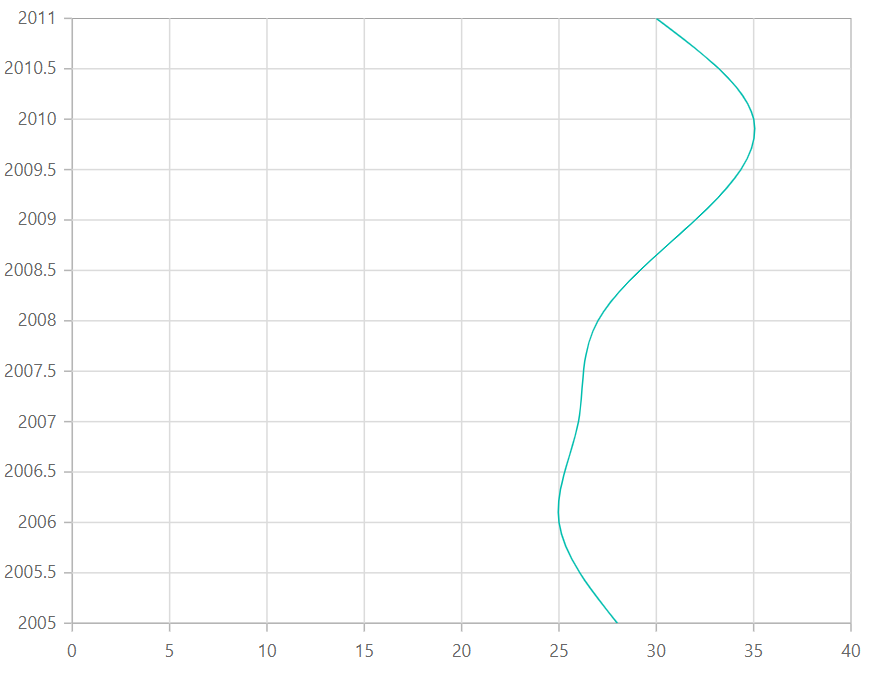Vertical Chart in Blazor Charts Component
11 Nov 202510 minutes to read
Vertical chart
One can draw a vertical chart by changing the axis orientation, and all series types support this option. To render a chart vertically, use the IsTransposed property.
@using Syncfusion.Blazor.Charts
<SfChart IsTransposed="true">
<ChartSeriesCollection>
<ChartSeries DataSource="@SalesReports" XName="X" YName="Y" Type="ChartSeriesType.Spline">
</ChartSeries>
</ChartSeriesCollection>
</SfChart>
@code{
public class ChartData
{
public double X { get; set; }
public double Y { get; set; }
}
public List<ChartData> SalesReports = new List<ChartData>
{
new ChartData{ X= 2005, Y= 28 },
new ChartData{ X= 2006, Y= 25 },
new ChartData{ X= 2007, Y= 26 },
new ChartData{ X= 2008, Y= 27 },
new ChartData{ X= 2009, Y= 32 },
new ChartData{ X= 2010, Y= 35 },
new ChartData{ X= 2011, Y= 30 }
};
}
Binding data with series
You can bind data to the chart using the DataSource property within the series configuration. The DataSource value can be set using either SfDataManager property values or a list of business objects. More information on data binding can be found here. To display the data correctly, map the fields from the data to the chart series’ XName and YName properties.
@using Syncfusion.Blazor.Charts
<SfChart IsTransposed="true">
<ChartSeriesCollection>
<ChartSeries DataSource="@SalesReports" XName="X" YName="Y" Type="ChartSeriesType.Spline">
</ChartSeries>
</ChartSeriesCollection>
</SfChart>
@code{
public class ChartData
{
public double X { get; set; }
public double Y { get; set; }
}
public List<ChartData> SalesReports = new List<ChartData>
{
new ChartData{ X= 2005, Y= 28 },
new ChartData{ X= 2006, Y= 25 },
new ChartData{ X= 2007, Y= 26 },
new ChartData{ X= 2008, Y= 27 },
new ChartData{ X= 2009, Y= 32 },
new ChartData{ X= 2010, Y= 35 },
new ChartData{ X= 2011, Y= 30 }
};
}Empty points
Data points with null, double.NaN or undefined values are considered empty. Empty data points are ignored and not plotted on the chart.
Mode
Use the Mode property to define how empty or missing data points are handled in the series. The default mode for empty points is Gap.
@using Syncfusion.Blazor.Charts
<SfChart IsTransposed="true">
<ChartSeriesCollection>
<ChartSeries DataSource="@SalesReports" XName="X" YName="Y" Type="Syncfusion.Blazor.Charts.ChartSeriesType.Spline">
<ChartEmptyPointSettings Mode="EmptyPointMode.Gap"></ChartEmptyPointSettings>
<ChartMarker Visible="true" Height="10" Width="10"></ChartMarker>
</ChartSeries>
</ChartSeriesCollection>
</SfChart>
@code {
public class ChartData
{
public double X { get; set; }
public double Y { get; set; }
}
public List<ChartData> SalesReports = new List<ChartData>
{
new ChartData{ X= 2005, Y= 28 },
new ChartData{ X= 2006, Y= 25 },
new ChartData{ X= 2007, Y= 26 },
new ChartData{ X= 2008, Y= double.NaN },
new ChartData{ X= 2009, Y= 32 },
new ChartData{ X= 2010, Y= 35 },
new ChartData{ X= 2011, Y= 30 }
};
}Fill
Use the Fill property to customize the fill color of empty points in the series.
@using Syncfusion.Blazor.Charts
<SfChart IsTransposed="true">
<ChartSeriesCollection>
<ChartSeries DataSource="@SalesReports" XName="X" YName="Y" Type="Syncfusion.Blazor.Charts.ChartSeriesType.Spline">
<ChartEmptyPointSettings Fill="#FFDE59" Mode="EmptyPointMode.Average"></ChartEmptyPointSettings>
<ChartMarker Visible="true" Height="10" Width="10"></ChartMarker>
</ChartSeries>
</ChartSeriesCollection>
</SfChart>
@code {
public class ChartData
{
public double X { get; set; }
public double Y { get; set; }
}
public List<ChartData> SalesReports = new List<ChartData>
{
new ChartData{ X= 2005, Y= 28 },
new ChartData{ X= 2006, Y= 25 },
new ChartData{ X= 2007, Y= 26 },
new ChartData{ X= 2008, Y= double.NaN },
new ChartData{ X= 2009, Y= 32 },
new ChartData{ X= 2010, Y= 35 },
new ChartData{ X= 2011, Y= 30 }
};
}Border
Use the Border property to customize the Width and Color of the border for empty points.
@using Syncfusion.Blazor.Charts
<SfChart IsTransposed="true">
<ChartSeriesCollection>
<ChartSeries DataSource="@SalesReports" XName="X" YName="Y" Type="Syncfusion.Blazor.Charts.ChartSeriesType.Spline">
<ChartEmptyPointSettings Fill="#FFDE59" Mode="EmptyPointMode.Average">
<ChartEmptyPointBorder Color="red" Width="2"></ChartEmptyPointBorder>
</ChartEmptyPointSettings>
<ChartMarker Visible="true" Height="10" Width="10"></ChartMarker>
</ChartSeries>
</ChartSeriesCollection>
</SfChart>
@code {
public class ChartData
{
public double X { get; set; }
public double Y { get; set; }
}
public List<ChartData> SalesReports = new List<ChartData>
{
new ChartData{ X= 2005, Y= 28 },
new ChartData{ X= 2006, Y= 25 },
new ChartData{ X= 2007, Y= 26 },
new ChartData{ X= 2008, Y= double.NaN },
new ChartData{ X= 2009, Y= 32 },
new ChartData{ X= 2010, Y= 35 },
new ChartData{ X= 2011, Y= 30 }
};
}Events
Series render
The OnSeriesRender event allows you to customize series properties, such as Data, Fill, and Series, before they are rendered on the chart.
@using Syncfusion.Blazor.Charts
<SfChart IsTransposed="true">
<ChartEvents OnSeriesRender="SeriesRender"></ChartEvents>
<ChartSeriesCollection>
<ChartSeries DataSource="@SalesReports" XName="X" YName="Y" Type="Syncfusion.Blazor.Charts.ChartSeriesType.Spline">
</ChartSeries>
</ChartSeriesCollection>
</SfChart>
@code {
public class ChartData
{
public double X { get; set; }
public double Y { get; set; }
}
public void SeriesRender(SeriesRenderEventArgs args)
{
args.Fill = "#FF4081";
}
public List<ChartData> SalesReports = new List<ChartData>
{
new ChartData{ X= 2005, Y= 28 },
new ChartData{ X= 2006, Y= 25 },
new ChartData{ X= 2007, Y= 26 },
new ChartData{ X= 2008, Y= 27 },
new ChartData{ X= 2009, Y= 32 },
new ChartData{ X= 2010, Y= 35 },
new ChartData{ X= 2011, Y= 30 }
};
}Point render
The OnPointRender event allows you to customize each data point before it is rendered on the chart.
@using Syncfusion.Blazor.Charts
<SfChart IsTransposed="true">
<ChartEvents OnPointRender="PointRender"></ChartEvents>
<ChartSeriesCollection>
<ChartSeries DataSource="@SalesReports" XName="X" YName="Y" Type="Syncfusion.Blazor.Charts.ChartSeriesType.Spline">
<ChartMarker Visible="true" Height="10" Width="10"></ChartMarker>
</ChartSeries>
</ChartSeriesCollection>
</SfChart>
@code {
public class ChartData
{
public double X { get; set; }
public double Y { get; set; }
}
public void PointRender(PointRenderEventArgs args)
{
args.Fill = args.Point.X.ToString() == "2008" ? "#E91E63" : "#3F51B5";
}
public List<ChartData> SalesReports = new List<ChartData>
{
new ChartData{ X= 2005, Y= 28 },
new ChartData{ X= 2006, Y= 25 },
new ChartData{ X= 2007, Y= 26 },
new ChartData{ X= 2008, Y= 27 },
new ChartData{ X= 2009, Y= 32 },
new ChartData{ X= 2010, Y= 35 },
new ChartData{ X= 2011, Y= 30 }
};
}NOTE
Refer to our Blazor Charts feature tour page for its groundbreaking feature representations and also explore our Blazor Chart Example to know various chart types and how to represent time-dependent data, showing trends at equal intervals.